Ellis,J. Pressure transients in water engineering, A guide to analysis and interpretation of behaviour
Подождите немного. Документ загружается.

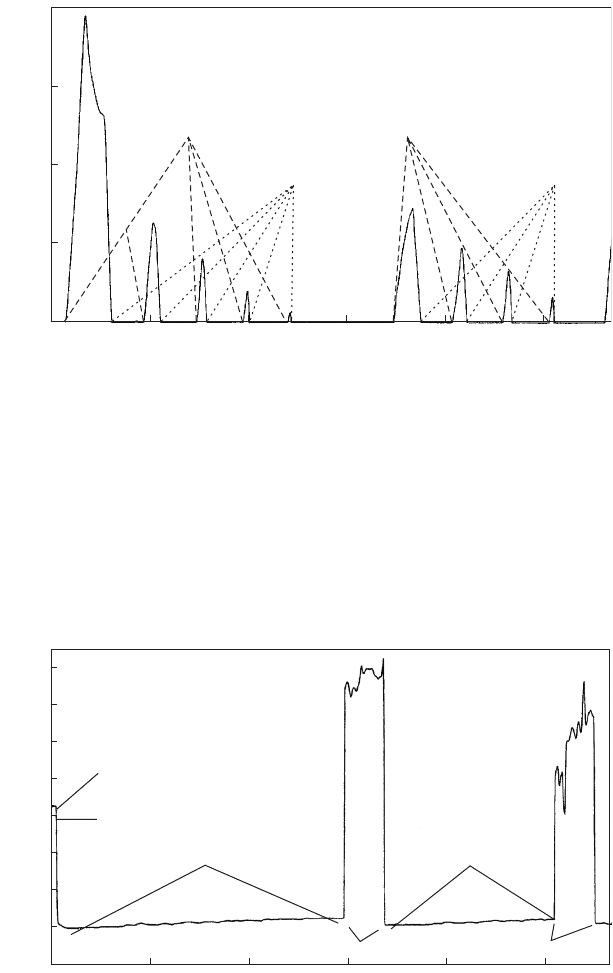
head rise after around 1.5 min. Subsequent reflection of the pressure
wave produced by this sudden head rise causes the valve to reopen
and a second period of air inflow and outflow to occur. This second
air flow interval is concluded with a further steep head rise, at around
2.5 min, to be followed by a third interval of air inflow. At chainage
2.19 km, head variations are more complicated (Fig. 17.14). Each
312
Air volume (l)
Time (min)
Air volume variation at chainage 2.19 km
0.5 1.0 1.5 2.0 2.5
Air valve opens
Air valve shuts Air valve shuts
Air valve opens
200
150
100
50
Fig. 17.12. Air volume at pipeline air valve
PS air valve shut PS air valve shut
70
60
50
40
30
20
10
0
Elevation (mHSD)
Time
(
min
)
Head variation at pumping station
0.5 1.0 1.5 2.0 2.5
Steady pumping head
Pump trip
PS air valve open PS air valve open
Fig. 17.13. Head at pumping station after trip
Pressure transients in water engineering
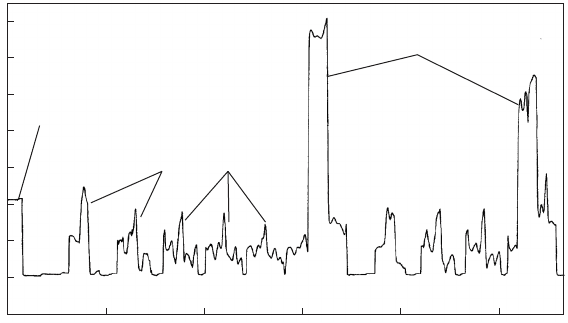
closure of this air valve produces an abrupt head rise and compression
waves whose reflection causes a further valve reopening. Behaviour at
this location is however dominated by the pumping station air valve
closures which produce the steep rise in head after around 1.5 min
and 2.5 min.
It is the uncontrolled acceleration dV=dt in the pipeline, between the
neighbouring open air valves which is responsible for the magnitude of
the differential velocity present upstream and downstream of the air
valve just as that valve shuts. Subsequent equalisation of velocities in
the main after air valve closure produces the shock pressure rise
predicted.
In view of the beneficial effect of throttling air outflow, it may be
thought that all air valves which may operate during a transient
event should have an air outflow regulating device fitted. A short-
coming of this approach can be the time taken for a large volume of
air to be expelled. During pipeline filling operations, if air outflow is
throttled at every valve in a system, the time taken to fill the main
could become excessive.
Where a number of air valves function during the initial downsurge
after a pumping failure, the subsequent behaviour of hydraulic transi-
ents can become quite complicated. The use of air valves can be
beneficial in relieving negative pressures as a result of pump trip.
Inflow of air via the air valves reduces rates of deceleration downstream
313
70
60
50
40
30
20
10
0
Elevation (mHSD)
Time
(
min
)
Head variation at chainage 2.19 km
Pump trip
Effects of air valve closure
at chainage 2.19 km
Effects of PS
air valve closure
0.5 1.0 1.5 2.0 2.5
Fig. 17.14. Head along pipeline after trip
Air valves
of a valve. Steepness of hydraulic gradient upstream of an operating valve
will tend to increase dV=dt in the up stream section of main. When flow
reverses it is important to control rates of air outflow and the magnitude
of the differential velocities developed at air valves prior to closure. In this
way, serious secondary pressure transients can be avoided.
17.6 Pump restart with air in a pipeline
Circumstances can arise where a pipeline may still contain pockets of air
at the time when a pump is started. This can be a consequence of pipe-
line typography, or it may arise because insufficient time has been
allowed to elapse between a previous pump trip and the restart of a
pump. Restarting of a pump with air remaining in the system may
possibly result in hydraulic transient and system operation problems.
It is necessary to ensure that any study of pressure transients in circum-
stances of pumping failure is continued for a sufficient length of time to
ensure that all possible venting of air has been completed. Built into any
pump control philosophy should be an adequate time delay between
stopping and restarting to allow air outflows to be completed.
If it is necessary to start a pump with an air pocket in the pipeline, the
same danger can arise as when a reversing water column purges air
through a typical large-orifice air valve. In this case the differential
flow rate occurs because the upstream pump discharge considerably
exceeds the downstream flow, which may be at or near zero.
Consider the Sharjah Main Drainage Pumping Station No. 1 and its
associated pipelines as already introduced in Chapter 16. Two mains
run in parallel: one is DN 450 and the other DN 700. As already
discussed, the demand for water to refill the pressure vessel at the
pumping station and the drawdown in level at the discharge chamber
does not permit completion of air venting through the air valves
around chainage 4.4 km on each pipeline. Appreciable air volumes of
5m
3
and 35 m
3
remained in the DN 450 and DN 700 mains respec-
tively when pumps were restarted.
With standard large-orifice air valves, air removal occurs relatively
quickly and with a relatively low pressure in the pipelines at the air
valves’ connection. This process is shown in Fig. 17.15. Air removal
from the DN 450 main has been completed before 1 min and from
the larger DN 700 main before 2 min. As regards head variations,
typical behaviour for the DN 700 main is shown in Fig. 17.16. Head
is initially varying fairly regularly under the control of the pressure
vessel. After about 1 min some irregularities appear caused by closure
314
Pressure transients in water engineering
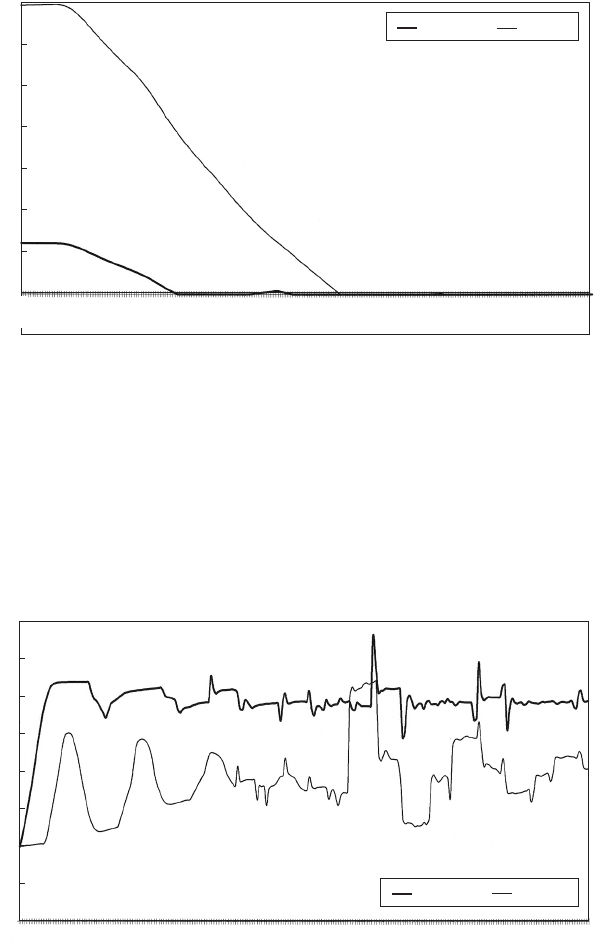
of the DN 450 pipeline air valve. At around 2 min the air valve on the
DN 700 main shuts, producing an abrupt head rise and further irregular
fluctuations in head.
Replacing the standard large-orifice air valves with restricted outflow
valves has the effects of prolonging air venting times and reducing the
secondary transient effects following air valve closure. Figure 17.17
315
Time
(
s
)
Sharjah PS No. 1
Air volume (m
3
)
AV 450 AV 700
35
30
25
20
15
10
5
0
–5
0.828
7.452
14.076
20.700
27.324
33.948
40.572
47.196
53.820
60.444
67.068
73.692
80.316
86.940
93.564
100.188
106.812
113.436
120.060
126.684
133.308
139.932
146.556
153.180
159.804
166.428
173.052
179.676
186.300
192.925
Fig. 17.15. Air removal on pump restart with large orifice in use
0.828
7.452
14.076
20.700
27.324
33.948
40.572
47.196
53.820
60.444
67.068
73.692
80.316
86.940
93.564
100.188
106.812
113.436
120.060
126.684
133.308
139.932
146.556
153.180
159.804
166.428
173.052
179.676
186.300
192.925
Time
(
s
)
Sharjah PS No. 1
Head (mASL)
strt 700 mid 700
40
35
30
25
20
15
10
5
0
Fig. 17.16. Head variation on pump restart with large-orifice outflow
Air valves
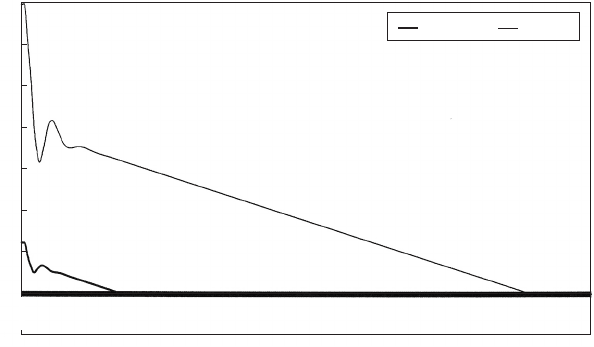
shows the manner in which air volume changes in the DN 450 and DN
700 pipelines when pumps are started. A relatively rapid initial reduc-
tion in each air volume occurs as the pumped flow compresses the air
masses. Some pressure wave effects are present, resulting in an oscilla-
tion in air volume before an almost steady rate of reduction in volume is
attained at each site. The time to completely remove the air mass in the
DN 450 main is around 7 min, while expulsion of the air pocket in
the DN 700 pipeline takes almost 37 min. The corresponding head
variations at the start and at the mid-point of the DN 450 main are
shown in Fig. 17.18. The start-up transient has dissipated before the
air valves close. At around 7 min when the valve on the DN 450
main shuts, only a modest head rise was predicted. Similar head changes
occur in the DN 700 main. After 7 min only very small effects of the DN
450 pipeline air valve closure were predicted to occur in the larger main.
After 37 min or so, closure of the air valve on the larger main also
produces a quite modest head rise.
Throttled air valve closure on the DN 700 main produces a more
modest transient effect than an identical valve on the DN 450 main.
The same valve will produce a smaller head rise on closure as pipeline
diameter increases. To illustrate this effect, for simplicity assume that
resistance is essentially that of the air valve throttle and this can be
represented as Q ¼ K
out
H
abs
, where Q is flow rate, H
abs
is absolute
pressure head at the valve connection and K
out
is the valve throttle
316
Time
(
s
)
Sharjah PS No. 1
Air volume (m
3
)
AV 450 AV 700
35
30
25
20
15
10
5
0
–5
0.828
79.488
158.148
236.809
315.469
394.129
472.789
551.450
630.110
708.770
787.431
866.091
944.751
1023.411
1102.072
1180.732
1259.392
1338.052
1416.713
1495.373
1574.033
1652.694
1731.354
1810.014
1888.674
1967.335
2045.995
2124.621
2203.247
2281.872
2360.498
2439.123
Fig. 17.17. Air removal using small orifice
Pressure transients in water engineering
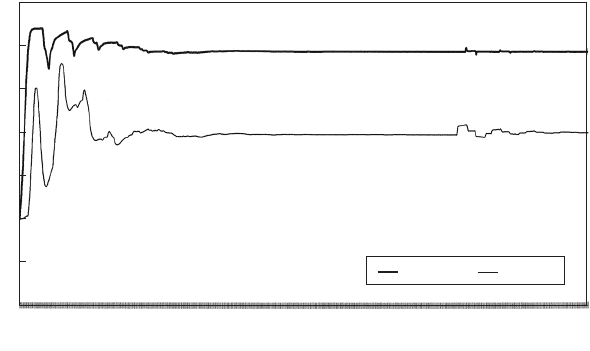
coefficient. Assuming that a steady venting rate has been achieved,
then for a given available head H
abs
:
VA ¼ K
out
H
abs
or V ¼ K
out
H
abs
=A
and head rise after valve closure, H
i
, is given by:
H
i
¼ aV=g ¼ aK
out
H
abs
=ðgAÞð17:8Þ
or, H
i
is proportional to 1=D
2
.
When air is being vented through an air valve along the pipeline, a
positive pressure is developed within the air mass below the air valve.
The magnitude of this positive pressure is dependent upon the
resistance imposed by the air valve orifice and upon the air outflow
rate. In the case of a large orifice, the positive pressure will be relatively
modest, resulting in a hydraulic grade line (a) in Fig. 17.19 and a pump
operating point (a) as illustrated. The pump will deliver > design flow to
the air valve connection site while the downstream pipeline stretch
experiences only a small acceleration because of the very limited
pressure rise at the valve connection. The differential velocity in the
pipeline across the air valve connection will therefore be relatively
large, leading to a significant head rise on valve closure. When a
small orifice with appreciable air outflow resistance is employed, pres-
sure in the air mass rises, producing an hydraulic grade line (b) in
Fig. 17.19. The pump operating point (b) is closer to the duty point
317
0.828
19.872
38.916
57.960
77.004
96.048
115.092
134.136
153.180
172.224
191.269
210.313
229.357
248.401
267.445
286.489
305.533
324.577
343.621
362.665
381.709
400.753
419.797
438.841
457.885
476.930
495.974
515.018
534.062
553.106
572.150
Time
(
s
)
Sharjah PS No. 1
Head (mASL)
strt of 450 mid 450
35
30
25
20
15
10
5
0
Fig. 17.18. Head variation with small orifice in use
Air valves
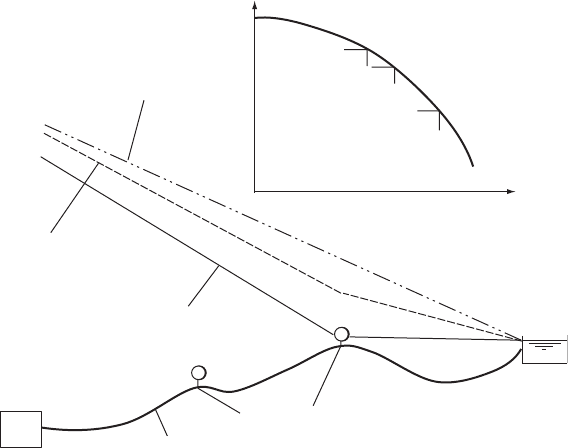
and flow rate from the pumping station to the air valve is < in case (a).
The increased pressure in the air mass produces a downstream hydraulic
gradient which is useful in accelerating the liquid column towards the
discharge point. When the air valve closes, the differential pipeline
velocity across the valve connection will be reduced considerably
from that with the large orifice. After steady flow has been achieved,
the hydraulic gradient will be as curve (c) with the corresponding
pump operating point (c).
17.7 Other considerations
Volumes of air drawn into a pipeline can range from a few litres to many
tens of cubic metres. In common with other hydraulic transient protec-
tion such as feeder tanks, an air valve at a high point adjacent to a
pumping station may be needed to provide the fluid required to allow
pressure vessel refilling at the pumping station.
17.7.1 Uncertainties in simulation
Prediction of pressure transients where a number of air valves operate
during the event can be readily conducted using available computer
318
HGL with system primed
(c)
(b)
(a)
Pump performance
H
Q
(c)
(b)
(a)
HGL with restricted outflow
through air valve
PS
HGL with free outflow
at air valve
Pipeline profile
Air valves
M
Fig. 17.19. Hydraulic gradient when venting air
Pressure transients in water engineering
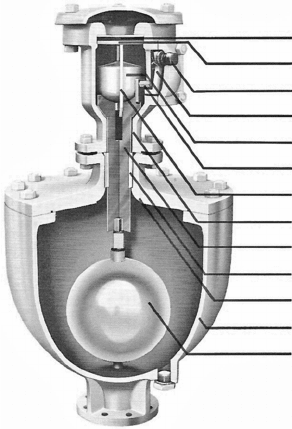
programs. Interactions between hydraulic transients produced by
closure of individual air valves can become quite complicated but this
is no impediment to the program. However, given the approximations
involved both in use of the gas law to represent behaviour of air
masses and overall air valve and chamber head loss characteristics,
calculations cannot be exact. This is especially the case where an
appreciable number of air valves are functioning. It may be advisable
to investigate the possibility of one or more critical air valves being
out of service. A critical valve is one which has an important influence
upon the progress of the transient. Due to the relatively low cost of air
valves, these have become a recognised solution to the task of pressure
transient alleviation. Prediction of their effects must be adequately
modelled and consideration given to any imperfections in the analysis,
especially where a large number of valves are involved.
17.7.2 Liquid being conveyed
Choice of air valves requires consideration of the liquid being conveyed.
When sewage is involved, the risk of a valve becoming blocked due to
matter being carried in the flow entering the valve has to be borne in
mind. Sewage air valves should have generous flow passages for liquid
in order to minimise possibility of malfunction. Figure 17.20 shows
319
Large orifice
Sealing ring
Small orifice
Small orifice lever
Air valve float
Tappet
Air valve float guid
e
Air valve unit
Elevator
Guide sleeve
Main cover
Float chamber
Operating float
Components
Fig. 17.20. Components of sewage air valve
Air valves
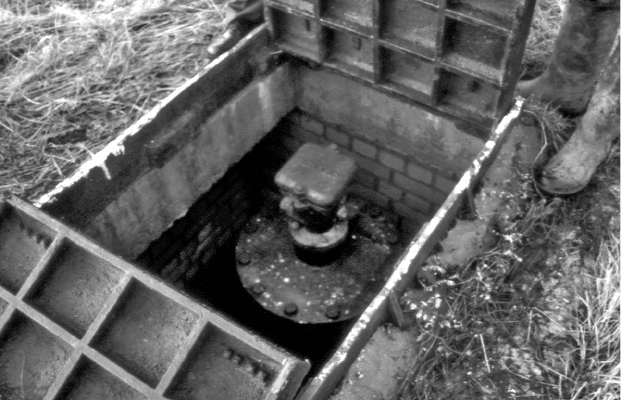
the large float chamber of the Glenfield ‘EPEX’ sewage air valve. Other
suppliers such as Erhard similarly provide a spacious float chamber for
their sewage valves.
17.7.3 Inspection
An adequate programme of inspection and maintenance of these valves
forms an important part of the overall package of protection for any
pipeline system. Figure 17.21 shows a sewage air valve chamber open
for inspection during transient tests.
17.7.4 Valve chamber and cover
Analysis usually assumes that the air external to the valve is at
atmospheric pressure, which itself may vary with climate and altitude.
The cover on any air valve chamber should allow sufficient air inflow
and outflow to satisfy this assumption and allow the air valve to
‘breathe’. Some modern highway covers for air valve chambers can be
so well sealed that during air venting the air in the chamber becomes
pressurised to such an extent that the top of the chamber eventually
fails, causing a hole to appear in the road surface or actually lifting
the road surface while the main is being charged, as described by
Burstall (1997). A more appropriate arrangement may be to have a
320
Fig. 17.21. Air valve chamber
Pressure transients in water engineering
vent pipe terminating above the ground surface so that a free inflow/
outflow from the chamber can take place and the air valve can function
as intended.
If air valve covers are not maintained and kept free from debris and
sand for instance, air flow can be inhibited and the performance of the
air valve may not be as modelled. Where a substantial number of air
valves are being used for the purpose of hydraulic transient suppression,
the possibility of malfunction will increase. Analyses conducted should
examine a range of possibilities to ensure that satisfactory transient
conditions are achieved with one or more valves not behaving as
intended.
17.7.5 Valve materials
Internal materials for floats, etc. can be thermoplastic or possibly stain-
less steel. The choice will depend to some extent on the duty, for
example the liquid being conveyed. Some plastics can be dissolved by
chemical effluents, resulting in pipeline contents escaping through a
damaged valve. Temperature should also feature in considerations. In
a hot climate, ambient temperature may reach or even exceed 408C.
If an air valve is exposed to this temperature and subject to high air
venting rates, heating within the valve may produce internal tempera-
tures of >808C. It has been known for plastic valve internals to soften
and become distorted under these conditions.
17.8 Buffer tanks and estimation of required volumes
It is quite common to find an air valve at the start of a rising main
downstream of a pumping station. While in many instances no special
provision is made to accommodate air admitted to the pipeline through
this air valve, in other circumstances a buffer tank may be included to
store this air volume offline, as shown in Fig. 17.22. In the first instance,
say for tendering purposes, it may be useful to estimate the required
volume of such a tank without having to resort to a detailed hydraulic
transient investigation. Determination of likely air volume admitted
directly to the rising main where no tank is provided can also be esti-
mated prior to any detailed study. The rigid column theory provides a
convenient means of establishing an initial air volume and thus tank
estimate.
Figure 17.23 illustrates circumstances following a pumping failure
when the transient piezometric level has fallen to the air valve operating
321
Air valves
